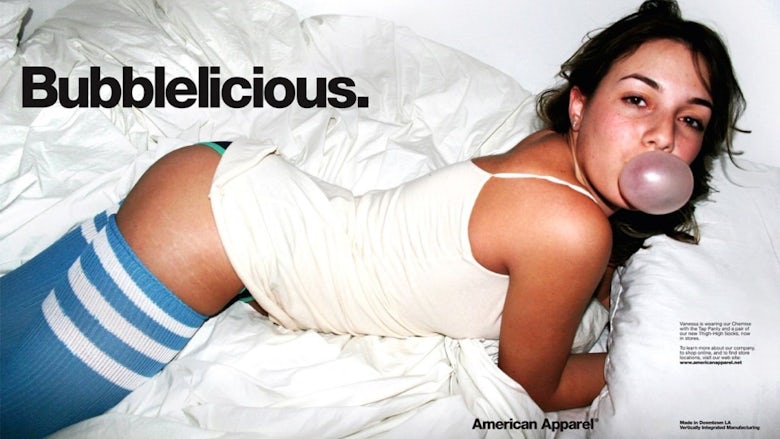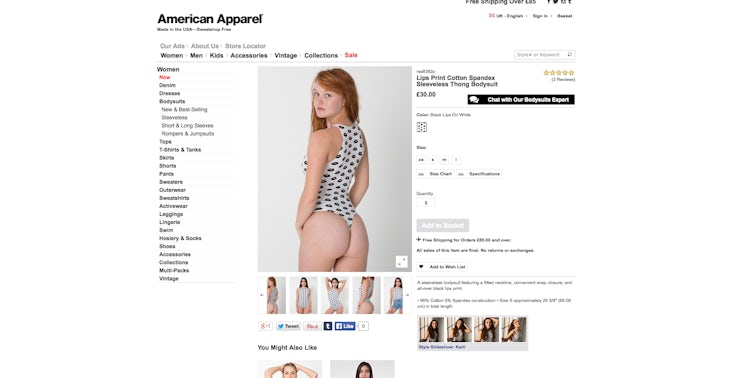From provocative to body positive: The American Apparel comeback
The LA-based fashion brand, remembered for its upskirt shots and sexualised advertising, is taking it back to basics after an 18-month hiatus.

American Apparel is back. Almost 18 months since the fashion brand went into administration it is plotting an unlikely comeback as it looks to shake off its controversial past while at the same time trying to return to what made it popular in the first place.
Key to that comeback is the new female-led marketing team, which is determined to change how people perceive the brand and put the focus back on the product. It is an interesting marketing challenge given the brand’s legacy of disco pants, bodysuits and semi-pornographic advertising.
Sabina Weber, American Apparel’s director of brand marketing for the last three years, is the first to hold her hands up and admit the brand “lost focus”. That’s an interesting way to put it, given the way it portrayed women in its advertising, which even Weber admits was “uncomfortable”.
“I look at those images and think ‘Oh my god, I would want nothing to do with this brand’,” Weber tells Marketing Week.
“We need to own up to the fact that historically there was a moment in time that it just went off the rails. It was way too sexual, it felt like the women were being compromised. It felt uncomfortable.”
Between 2008 and 2015 the UK’s advertising watchdog the Advertising Standards Authority (ASA) banned nine American Apparel ads for reasons including concerns that they sexualised children and normalised sexual predatory behaviour. In 2015, it landed itself in its final puddle of hot water with an online ad showing a model that was deemed to look under 16 wearing a thong bodysuit.
In just a few short years, American Apparel had gone from being known as an ethical, forward-thinking brand that did colourful sweatshop-free hoodies and was an advocate for LGBTQ and immigration rights, to one that did nudes with several public sexual harassment lawsuits under its belt.

Since then, the marketing department has undergone a complete overhaul. Once primarily led by men, it is now smaller and mostly women – and with a “pretty small” budget to match a relatively low-key launch back into the online world.
Everything is now done in-house too – the photography, re-touching, designing, PR and marketing, which Weber says has a bit of a DIY feel that encourages people to get creative.
“It’s not Gucci level, let’s put it that way,” she says. “It has to be in relative alignment with what the brand is going to make but it is certainly something that is enough to sustain us.”
READ MORE: The secrets of achieving cult status
With that in mind, American Apparel is relying on organic growth from social media – Instagram in particular – and user generated content to drive brand awareness (although observant Londoners might have noticed a few bus stop ads this week).
However, one area where American Apparel will not be investing is influencers who, Weber says, “charge thousands of dollars for a post”. Not only is that beyond the brand’s budget, Weber would rather find real people that want to engage with the brand and “love what it stands for”.
What does American Apparel want to stand for in 2018?
So what does this new American Apparel stand for? Weber says her team are trying to put the focus back on the brand that made it what it was in its “hey day”.
“The focus has to be on the product because that’s what people are buying, and the effect of the product is that it makes you feel good,” Weber says. “So we’re focusing on a really strong range of girls, of all shapes and sizes, and we’re keeping it positive.”

That doesn’t mean we won’t still see scantily-clad women. “People should be able to feel sexy, there’s nothing wrong with that so let’s not go completely crazy and cover up,” Weber laughs.
“People are like, why are we still showing side-boobs? Why are we still showing breasts? Because those are fun. People feel good and if you feel good in your body it should be fun. So we show girls and guys – people – feeling good in their bodies. All bodies, un-retouched bodies. Let’s show stretch marks, skin anomalies, let’s redefine what is beautiful.”
But American Apparel’s challenges go beyond just changing how people feel about the brand. The ecommerce market has changed significantly over the last two years, and with the rise of brands such as Asos, Boohoo and Misguided, American Apparel will need to find a point of difference in a growing and competitive market – especially as it doesn’t now have a high street presence.
“Online, we obviously have to make the product more compelling because people can’t touch it. So how do you get somebody to take a chance on something they’re not familiar with?,” Weber asks.
We lost the focus on the good quality product and what made the brand strong and cool and fun.
Sabina Weber, American Apparel
“The [ecommerce] market is incredibly competitive. There’s no magic, we’re all doing the same thing. It comes down to the really key differentiators, which for us is a quality product that people can trust at an available price.
“Innovation is important too: coming out with strong, foundational new basic pieces that are staples in your wardrobe.”
Customer experience will also be important, with Weber saying offering a free and easy return policy is “critical”. She admits the current website doesn’t have the “shiniest tech” – although the company is currently looking at how artificial intelligence can enhance the customer experience – but claims that is authentic for the brand and “basic, just like the product”.
Does Weber think people will be willing to give American Apparel another chance?
“I hope so,” she says. “We lost the focus on the good quality product and what made the brand strong and cool and fun. There’s a lot of passion and love we’ve put into putting us back out into the market. There’s not going to be one massive big bang; it really is a consistent, unique, strong, visual brand message that hopefully people can begin to engage with.”






